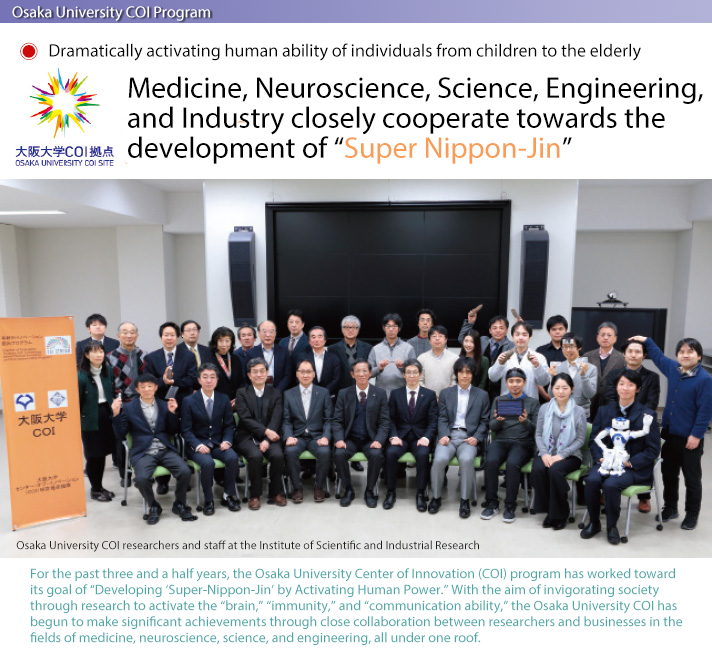
Medicine, Neuroscience, Science, Engineering, and Industry closely cooperate towards the development of “Super Nippon-Jin”
Selecting challenges in R&D to be addressed for a society 10 years in the future through industry-academia collaborative teams
The “Center of Innovation Science and Technology based Radical Innovation and Entrepreneurship Program (COI STREAM)” is a project sponsored by the Ministry of Education, Culture, Sports, Science and Technology. In anticipation of the society 10 years in the future at which the Osaka University COI aims, this project selects innovative research themes and strives to achieve revolutionary innovation which cannot be achieved by industry alone through industry-government-university collaboration.
Unlike conventional approaches which think of commercialization as seeds developed from research at a university, this project aims at innovation by setting challenges in R&D to be addressed by industry-academia collaborative teams toward a society 10 years in the future at which the Osaka University COI aims.
Innovation center for energizing society as a whole by activating “brain power,” “immunity,” and “communication ability”
The Osaka University Center of Innovation (COI) is one of 18 COI sites nationwide. As a center for the project “Developing ‘Super Nippon-Jin’ by Activating Human Power,” the Osaka University COI aims to energize society as a whole by dramatically activating human power of individuals from children to the elderly while maximizing their potential.
 Vice Director Kazuhiko MATSUMOTO,
Research Leader at the Osaka University
Organization for COI Research, said, “I felt a sense of urgency
regarding the current state of Japanese society. I wanted to invigorate Japan
by making introverted young people as well as the elderly, whose number is
increasing, energetic.” The way to accomplish this is to activate human “brain
power,” “immunity,” and “communication ability.” The means of achieving this
goal is activating human “brain power,” “immunity,” and “communication
ability.”
Vice Director Kazuhiko MATSUMOTO,
Research Leader at the Osaka University
Organization for COI Research, said, “I felt a sense of urgency
regarding the current state of Japanese society. I wanted to invigorate Japan
by making introverted young people as well as the elderly, whose number is
increasing, energetic.” The way to accomplish this is to activate human “brain
power,” “immunity,” and “communication ability.” The means of achieving this
goal is activating human “brain power,” “immunity,” and “communication
ability.”
The Osaka University COI has three features: “Medicine-Neuroscience-Engineering-Science-Collaboration,” “Open Innovation,” and “International University-Industry Collaboration.” Osaka University, with its advanced research environment in the field of neuroscience adopts the idea of collaboration among 7 departments -- Medicine-Neuroscience-Science-Engineering Collaboration. The fields of neuroscience and science have been added to conventional collaboration between medicine and engineering.
Previously, for intellectual property reasons, industry-university collaboration was often carried out between one laboratory and one company. However, at the Osaka University COI, multiple laboratories, 27 companies, and 17 institutes worked together to create an “open innovation environment” to allow free sharing of intellectual property rights including patents in a specific area. In addition, based on “international industry-university collaboration” with the world’s largest nanotechnology consortium in which 600 companies in 62 countries perform research, the Osaka University COI has been involved in ambitious challenges.

(Osaka University COI website: https://www.coistream.osaka-u.ac.jp/en/)
Research results, including brain wave sensors and functional foods, have been commercialized into market
Brain activation research currently gaining the most attention is research on a “brain management system,” a system to detect the human stress condition using electroencephalograph (EEG) to achieve a stress-free environment. The Osaka University COI succeeded in developing Artificial Intelligence (AI) that automatically composes music to a wearer’s taste based on his/her brain waves that are sensed by a brain wave sensor with headphones. Researchers presented this device at the Wearable EXPO in January 2018 to much praise. Also, the researchers at the Osaka University COI developed a wearable patch-type brain wave sensor for the purposes of improving the quality of sleep and early detection of depression and Alzheimer-type dementia by measuring brain waves.

In addition, regarding “immunity activation,” research focusing on intestinal flora, which is said to be greatly involved in the immune system, is progressing in collaboration with local municipal governments. Currently, functional foods that promote normalization of intestinal flora are in the trial production stage.

Social implementation through collaboration with companies
The Osaka University COI, which made steady progress in Phase 1 over the last three years, is currently entering Phase 2 in which data showing brain and immunity activation are being collected in verification tests. However, the COI is strongly pressured to commercialize research achievements, so Vice Director Matsumoto shows his determination, saying, “We are seeking further collaboration with companies that fit with what we are looking for.”